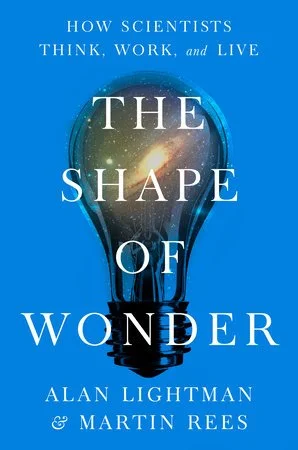"THE SHAPE OF WONDER"
“The Shape of Wonder: How Scientists Think, Work, and Live, by Alan Lightman and Martin Rees, Pantheon, 224 pp.
Carl Sagan warned us. In his 1995 book The Demon Haunted World, Sagan looked to the future with dread.
“We've arranged a global civilization in which most crucial elements profoundly depend on science and technology. We have also arranged things so that almost no one understands science and technology. This is a prescription for disaster. We might get away with it for a while, but sooner or later this combustible mixture of ignorance and power is going to blow up in our faces.”
No further evidence of our pandemic of ignorance is needed. It’s time for solutions, ways to bridge the growing gap between science and superstition, thinking and refusing to think. The Shape of Wonder: How Scientists Think, Work, and Live is one such solution.
Alan Lightman (above) is that rare bridge between science and the humanities. A M.I.T. physicist who is also the author of Einstein’s Dreams and other acclaimed novels, Lightman is an ideal guide to the wonders of science. His co-author, Martin Rees, has gone beyond his position as England’s Astronomer Royal to write popular books about the dangerous existential cocktail of ignorance, superstition, and technology.
Together, Lightman and Rees have crafted a deft portrait of science and scientists in action. Profiling several scientists in daily life, they juxtapose thoughts on the rigors of critical thinking with what physicist Richard Feynman called “the pleasure of finding things out.”
Written for folks who are either curious or else a little wary of science, The Shape of Wonder begins by showing how far science has fallen in the public eye. This “disciplined wonder” was once considered the savior of humanity, a relief from the “vale of tears” the superstious world had made.
Yet today, untold millions distrust science and fear scientists as “elite,” “corporate flacks,” or worse. Even as COVID raged and science produced a vaccine in record time, anti-vaccination BS led to the deaths of 300,000 unvaccinated in America alone. Are scientists “disconnected from the lives of ordinary people?”
Lightman and Rees know better. “In humanizing scientists,” they write, “we think it might be helpful to meet a few of them.”
So meet Werner Heisenberg, boy wonder of quantum theory, waxing eloquent on the “strangely beautiful interior” that his Uncertainty Principle uncovered. And meet biologist Barbara McClintock (below) lovingly cultivating diverse breeds of corn to make breakthroughs in genetics. We also meet less famous scientists, workaday folk with families, fears, and, it just so happens, a childlike fascination with their fields.
Alternating with profiles are chapters on “How Scientists Think,” “What Gets Them Started,” and “What Keeps Them Going.” The result is a consumer’s guide for a society that depends on science every day yet knows next to nothing about the people who make it.
What we do not know about science might not kill us but it sure can confuse. What many see as scientists “changing their minds” about nutrition, face masks, and other precautions is, in fact, the scientific method. “When scientists change their recommendations, it is not because they are wishy-washy. It is because new information has become available.” And contrary to the layman’s conceit that a scientific “theory” is a mere “conjecture or a guess,” theories of relativity, evoltuion, etc. are “large conceptual frameworks” submitted to rigorous testing and re-testing. Yet some prefer to trust Youtube videos.
Einstein, toward the end of his life, continued to marvel at both the cosmos and humanity. “Two things are infinite,” he wrote, “the universe and human stupidity. And I’m not sure about the universe.”
Fortunately, science inspires as much wonder as despair, and the shape of that wonder can be a welcome vaccination against the pandemic of superstition. Alan Lightman and Martin Rees go a long way toward defining that shape and reclaiming science as a human endeavor practiced by people like us. We should pay attention this time.





